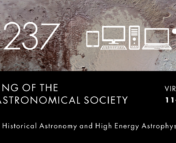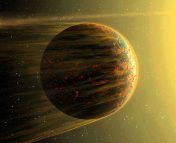Title: How to identify exoplanet surfaces using atmospheric trace species in hydrogen-dominated atmospheres
Authors: Xinting Yu (余馨婷), Julianne I. Moses, Jonathan J. Fortney, Xi Zhang
First Author’s Institution: University of California Santa Cruz
Status: Published in ApJ, available on arXiv
Of the 4400 (and counting!) exoplanets, the population of intermediate-sized planets is one of the most interesting. With sizes between Earth and Neptune not seen in our Solar System, the most commonly occurring type of planet can be a confusing one. A planet in this category could be a giant terrestrial planet, with a solid surface and thin atmosphere (a “super-Earth”), or it may be more like a shrunken down version of the Solar System’s ice giants (a “sub-Neptune”), with a surface located deeper within the planet at high-pressure levels, if there is one at all. Even though many intermediate-sized exoplanets have been discovered, the internal structure of any one planet isn’t always clear. Large uncertainties in the masses and radii of these planets, and hence in their densities, can make understanding their precise compositions a challenge, and even the most sensitive upcoming telescopes like JWST and ARIEL cannot directly probe surfaces, leaving many exoplanets in composition limbo.
However, JWST and ARIEL will be capable of precisely measuring the atmospheres of such planets, so what if there was a way to find out how deep the surface of an exoplanet lies by studying its atmosphere? The author’s of today’s paper investigates the relation (if there is one) between the abundances of species found in the exoplanet’s atmosphere and the location of an exoplanet’s surface.
Under Pressure
As it turns out, the existence of a solid surface plays a key role in the makeup of the atmospheres within our own Solar System. Both Jupiter and Saturn’s moon Titan contain very little ammonia (NH3) within their upper atmospheres, as it gets destroyed by photochemical reactions which occur there, however, while Jupiter contains significant amounts of NH3 deep within its atmosphere, Titan does not. The difference here is Titan’s surface. In Jupiter, the lack of a solid surface means the constituent parts of NH3 are transported into the hot, high pressure lower atmosphere where they can reform into ammonia via thermochemical reactions, whereas Titan’s surface prevents its atmosphere from reaching high enough temperatures and pressures for the recycling reactions to occur. Titan instead has a larger abundance of nitrogen, leftover from the destroyed NH3.
The authors propose that a similar situation could occur with other species within the atmospheres of exoplanets. To test this theory, they modelled the impacts of having no surface and having a surface at one of three different pressure levels on the atmospheric evolution of K2-18b, a sub-Neptune.

Figure 1: Diagrams describing the main chemical pathways within the atmosphere of K2-18b for a deep or no surface (left) and a shallow surface (right). Arrow thickness indicates the importance of each pathway, with dashed arrows being the least important. In both cases, UV photons impacting the upper atmosphere cause photochemical reactions which break down sensitive molecules such as NH3, HCN, H2O and CH4. In the deep/no surface model, thermochemistry in the deep, hot atmosphere recreates the molecules lost to photochemistry. In the shallow surface case, atmospheric temperatures are never hot enough for thermochemistry to be effective, causing a decrease in abundance of the species in blue compared to the no surface case, and an increase for the red species. Figure 2 in the paper.
Much like within the Solar System, if K2-18b has a shallow surface, the atmosphere is never hot enough for thermochemical reactions to take place, meaning the abundances of photochemically fragile species such as ammonia decrease compared to when the surface is much deeper or non-existent, as shown in Figure 1. For each version of the model, the changes in the volume mixing ratios (VMR) of key chemical species within the observable atmosphere demonstrate the impacts of surfaces at different pressure levels.

Figure 2: Plots showing how the volume mixing ratios of key chemical species change with pressure through the atmosphere of K2-18b with different surfaces. Higher pressures indicate deeper into the atmosphere. The pale blue shaded region indicates the observable part of the atmosphere. Figure 3 in the paper.
When the planet has no surface or a very deep surface, large amounts of hydrocarbons and nitrites such as hydrogen cyanide (HCN) are produced, while significant quantities of ammonia are found deep in the atmosphere just like in the case of Jupiter. When a surface exists at 10 bars, key nitrogen species can no longer be replenished and produced as easily, leading to decreasing VMRs for HCN and NH3. For the shallowest, Earth-like surfaces, thermochemistry is prevented for the majority of species, and the atmosphere is now also depleted in water (H2O) and methane (CH4). As Figure 2 shows, changing the surface of a planet will change the abundances of a whole host of species, but are these changes significant enough to distinguish between surfaces?
A New Tool For Observers?
Using the finding that a variety of species are uniquely sensitive to the presence of different surfaces, the authors are able to use the abundance ratios between a species when a surface is and isn’t present, and between different pairs of species to tentatively outline a way to distinguish where a surface could be.
![The image shows a flowchart for determining the surface of a planet. The flowchart begins at the top with a blue box labelled "Atmospheric characterization". Following the flowchart, below and to the right an arrow leads to a green box labelled when "f[NH3]~1 f[HCN]~1", which then leads to a red box directly below it labelled "Deep surface (p>100 bar)". Returning to the blue box, below and to the left an arrow leads to another green box labelled when "f[NH3]<1 f[HCN]<1". Two arrows lead down and away from this box, each to orange boxes. The orange box on the left reads when "f[CH4]<1 f[C2H2]<1 f[CO/CH4]>1 f[CO/H2O]>1", and leads to a red box directly below it labelled "Shallow surface (p>10 bar). The orange box on the right reads when "f[CH4]~1 f[C2H2]~1 f[CO/CH4]<1 f[CO/H2O]<1", and leads to a red box directly below it labelled "Intermediate surface (10 bar < p <100 bar). A caption at the very top of the figure reads "When X = single species, f[X]=[X]/[X](no-surface). When X = species A/species B, f[X]=[A]/[B]"](https://astrobites.org/wp-content/uploads/2021/07/flowchart-300x169.png)
Figure 3: Flowchart to aid in the possible determination of the pressure level of a surface within an exoplanet similar to K2-18b using the observed abundances ([X]) ratios of different species. Adapted from Figure 9 in the paper.
With the flowchart shown in Figure 3 to hand, it could be possible to determine where surfaces lie within exoplanets, provided accurate abundance measurements are available. Unfortunately, current measurements of K2-18b’s Neptunian atmosphere aren’t precise enough to make a prediction about any potential surface, but upcoming JWST observations of this planet could help to shed light on the mystery.
So, does this mean the mystery of intermediate planet surfaces can finally be resolved? Not completely. More modelling is needed to extend the range of planetary parameters and scenarios. In the future, the flowchart could be expanded to include exciting but less well-studied species such as phosphine (PH3). The current study also does not consider the potential impacts of processes that occur on the surface, such as volcanic activity and reactions with oceans or rocks, or the potential escape of gases from the top of the atmosphere – all processes which could change the observed abundance ratios in an exoplanet. Nevertheless, today’s paper outlines an exciting new concept that extends our toolkit as we continue to try and understand the growing number of strange new worlds waiting to be explored.
Astrobite edited by Alice Curtin
Featured image credit: Amanda Smith




